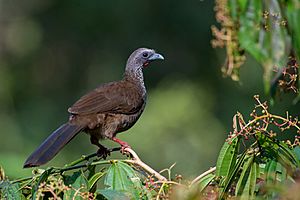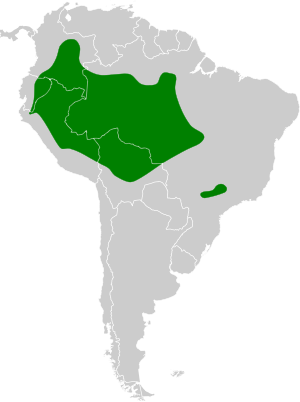Speckled chachalaca facts for kids
Quick facts for kids Speckled chachalaca |
|
|---|---|
 |
|
| Conservation status | |
| Scientific classification | |
| Genus: |
Ortalis
|
| Species: |
guttata
|
 |
|
The speckled chachalaca (Ortalis guttata) is a type of bird that lives in South America. It is part of the Cracidae family, which includes other chachalacas, guans, and curassows. You can find this bird in countries like Bolivia, Brazil, Colombia, Ecuador, and Peru.
Contents
About Its Name and Family
Scientists often study animals to understand how they are related. The speckled chachalaca's family tree has changed over time. For a while, it was thought to be the same species as the variable chachalaca. But scientists later realized they were different.
Later, three more types of chachalacas were found to be separate species from the speckled chachalaca. These include the East Brazilian, Scaled, and Colombian chachalacas.
Today, the speckled chachalaca has three main groups, called subspecies. These are O. g. guttata, O. g. subaffinis, and O. g. remota. Sometimes, scientists debate if O. g. remota should be its own species.
What It Looks Like
The speckled chachalaca is about 49 to 55 centimeters (19 to 22 inches) long. The most common type, O. g. guttata, is mostly brown on its back. Its head and neck are a bit darker and grayer.
Its tail has a shiny bronze look, and the outer feathers are reddish-brown. The bird's throat and chest are dark brown with white spots, which is how it got its name "speckled." Its lower chest and belly are light grayish-brown. The area under its tail is bright reddish-brown. It has dark brown eyes surrounded by bare, slate-blue skin.
The O. g. subaffinis subspecies is lighter and more brown than the common type. It does not have the reddish-brown color on its back. The spots on its throat and chest look more like scallops. This subspecies is also a bit bigger.
The O. g. remota subspecies looks different too. Its head is reddish instead of gray. It is lighter and more olive-colored on its back. Its rump (lower back) is reddish-brown. The "speckles" on this bird are larger and not as clear.
Where It Lives and Its Home
The common speckled chachalaca (O. g. guttata) lives in the Amazon region. This includes eastern Colombia, Ecuador, Peru, northern Bolivia, and western Brazil.
The O. g. subaffinis subspecies lives in eastern and northeastern Bolivia. It also lives in nearby southwestern Brazil.
The O. g. remota subspecies lives far away from the others. It is found in southeastern Brazil, in the states of Mato Grosso do Sul and São Paulo.
These birds live in many kinds of warm, wet places. The Amazonian subspecies prefer open forests, thick bushes, or small groups of trees in grassy areas. They also like forests near rivers. They usually avoid the deep parts of dense forests. They can be found at higher elevations in the western parts of their range.
The O. g. remota subspecies lives only in new forests that have grown back. It also lives at the edges of forests that follow rivers.
Behavior
Feeding
Speckled chachalacas usually look for food in small groups. These groups can have up to seven birds. They mostly search for food in the middle and lower parts of trees. They rarely look for food on the ground. We do not know much about their diet. But they are known to eat fruits and other parts of plants.
Reproduction
Scientists do not know much about how speckled chachalacas reproduce. Their nesting season seems to change depending on where they live. In Peru, they nest from at least November to March. One nest found was made entirely of leaves on a bed of dry ferns. A female bird usually lays three to four eggs.
Vocalization
The song of the common speckled chachalaca is a "rhythmic five-syllable phrase." It sounds like ha-ga-GAA-gogok and is repeated quickly. The songs of the other subspecies are similar.
Conservation Status
The IUCN (International Union for Conservation of Nature) says the speckled chachalaca is a species of "Least Concern." This means it is not currently in danger of disappearing.
The two Amazonian subspecies are common in their homes. They live in protected areas in every country. They seem to handle human activity quite well. Also, people hunt them less often than other chachalacas.
However, the O. g. remota subspecies is very rare. Much of its home was flooded by big dams built for electricity. Because of this, Brazilian authorities consider it "Critically Endangered."
See also
 In Spanish: Guacharaca moteada para niños
In Spanish: Guacharaca moteada para niños


